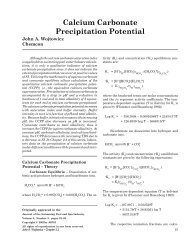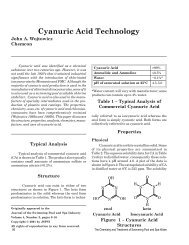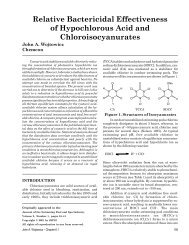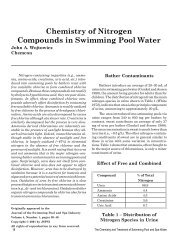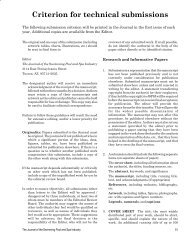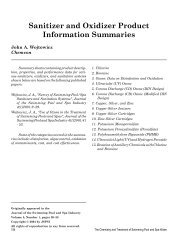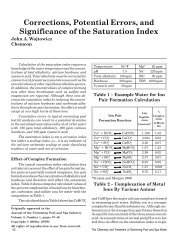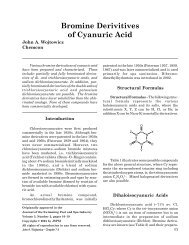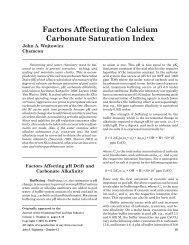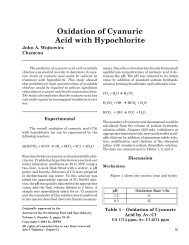The Carbonate System in Swimming Pool Water - jspsi
The Carbonate System in Swimming Pool Water - jspsi
The Carbonate System in Swimming Pool Water - jspsi
Create successful ePaper yourself
Turn your PDF publications into a flip-book with our unique Google optimized e-Paper software.
<strong>The</strong> <strong>Carbonate</strong> <strong>System</strong> <strong>in</strong><br />
Swimm<strong>in</strong>g <strong>Pool</strong> <strong>Water</strong><br />
John A. Wojtowicz<br />
Chemcon<br />
<strong>The</strong> carbonate system <strong>in</strong> swimm<strong>in</strong>g pool water<br />
is described, and formulas are given to calculate the<br />
various components of the system.<br />
<strong>The</strong> three techniques for carbon dioxide determ<strong>in</strong>ation<br />
found <strong>in</strong> Standard Methods (APHA 1995)<br />
are also discussed, and are compared to the more<br />
complex equations, with examples.<br />
<strong>The</strong> carbonate system <strong>in</strong> swimm<strong>in</strong>g pool water<br />
consists primarily of bicarbonate ions with small<br />
concentrations of carbonate ions that are the alkal<strong>in</strong>e<br />
constituents. <strong>The</strong> water also conta<strong>in</strong>s low concentrations<br />
of dissolved carbon dioxide (
solids or TDS). S<strong>in</strong>ce it is difficult to dist<strong>in</strong>guish<br />
between dissolved carbon dioxide and carbonic acid<br />
by analytical means, a hypothetical species (H 2 CO 3 *)<br />
is used <strong>in</strong> the second equilibrium expression above to<br />
represent the total. This also reduces the number of<br />
carbonate species from four to three and simplifies<br />
calculations.<br />
H 2 CO 3 * = H 2 CO 3 + CO 2 (aq)<br />
<strong>The</strong> <strong>in</strong>dividual activities <strong>in</strong> the above equilibrium<br />
expressions can be represented as a product of<br />
an activity coefficient (γ) and a species concentration<br />
(mol/L).<br />
[H CO ]γ 2 3 H2CO / ([CO2 (aq)]γ ) = K<br />
CO2 (aq)<br />
3<br />
– [H+]γ +<br />
H [HCO ]γHCO3–<br />
/ ([H CO * ]γ 3<br />
2 3 H2CO *<br />
) = K1 3<br />
[H + 2 – – ]γ + [CO ]γCO3<br />
H 3 2 – / ([HCO ]γHCO3<br />
3 – ) = K2 Concentration Equilibrium Constants<br />
<strong>The</strong> activity coefficients can be comb<strong>in</strong>ed with<br />
the thermodynamic equilibrium constants to yield<br />
concentration equilibrium constants as follows:<br />
[H 2 CO 3 ] / [CO 2 (aq)] = K γ CO2 (aq) / γ H 2 CO 3 = c K<br />
[H + – ][HCO ] / [H2CO * ] = K γ 3<br />
3 1 H2CO * / (γ +<br />
H γ – ) = HCO3<br />
3 cK1 [H + 2 – – ][CO ]/[HCO3]<br />
= K2 γ – /(γ +<br />
3<br />
HCO3 H γ 2 – ) = CO3<br />
cK2 Ionic Strength Correction<br />
Activity coefficients are calculated us<strong>in</strong>g the<br />
Davies Approximation (Stumm and Morgan 1996)<br />
where µ is the ionic strength and z the ionic charge.<br />
Log γ = – 0.5z 2 [√µ / (1 + √µ) – 0.3µ]<br />
Ionic strength is calculated from ppm TDS accord<strong>in</strong>g<br />
to the follow<strong>in</strong>g equation:<br />
µ = 2.5x10 – 5 TDS<br />
Because H 2 CO 3 and CO 2 (aq) are not ionic species,<br />
their activity coefficients are taken as unity.<br />
Experimental Equilibrium Constants<br />
Temperature (degrees Kelv<strong>in</strong>) dependent equa-<br />
tions for K 1 and K 2 (Plummer and Busenberg 1982)<br />
are as follows:<br />
Log K 1 = – 356.31 – 0.06092T + 21834.4 / T<br />
+ 126.834 Log T – 1684915 / T 2<br />
Log K 2 = – 107.887 – 0.032528T + 5151.79 / T<br />
+ 38.9256 Log T – 563713.9 / T 2<br />
Calculated values of K, K 1 and K 2 at 25°C and 0 and<br />
500 ppm TDS are shown <strong>in</strong> Table 1.<br />
Equilibrium Total Dissolved Solids<br />
Constant 0 ppm 500 ppm<br />
Concentration of Species<br />
<strong>The</strong> total molar concentration of carbonate<br />
species is represented by the equation:<br />
– 2 – C = [H CO * ] + [HCO ] + [CO3 ]<br />
T 2 3 3<br />
<strong>The</strong> molar concentrations of <strong>in</strong>dividual species as a<br />
function of ionization fraction (α) are given by:<br />
– 2 – [H CO * ] = C α ; [HCO ] = CTα ; [CO ] = CTα 2 3 T 0 3<br />
1 3<br />
2<br />
[H 2 CO 3 ] = K[CO 2 (aq)] ≅ K[H 2 CO 3 * ]<br />
Where:<br />
K 1.54x10 -3 1.54x10 -3<br />
K 1 4.44x10 -7 5.48x10 -7<br />
K 2 4.69x10 -11 7.13x10 -11<br />
Table 1 – Calculated Equilibrium<br />
Constants at 25°C<br />
α = (1 + 0 cK / [H 1 + ] + c c K K2 / [H 1<br />
+ ] 2 – 1 )<br />
α = ([H 1 + ] / cK + 1 + 1 cK / [H 2 + – 1 ])<br />
α = ([H 2 + ] 2 / ( c c K K2 ) + [H 1<br />
+ ] / c – 1 K + 1) 2<br />
[H + ] = 10 – pH / γ H + is the hydrogen ion concentration.<br />
John A. Wojtowicz – Chapter 1.1 5
Ionization Fractions vs. pH<br />
A plot of ionization fractions vs. pH is shown <strong>in</strong><br />
Figure 1. <strong>The</strong> plot shows that as pH <strong>in</strong>creases CO 2 (aq)<br />
and the small amount of H 2 CO 3 are converted stepwise<br />
<strong>in</strong>to bicarbonate and carbonate ions, the reverse<br />
be<strong>in</strong>g true when pH decreases. <strong>The</strong> plot also shows<br />
that at a median pH (i.e., 7.5) that CO 2 (aq) is only a<br />
m<strong>in</strong>or constituent of pool water, correspond<strong>in</strong>g to<br />
only about 6% of the total species.<br />
Alkal<strong>in</strong>ity<br />
For pools conta<strong>in</strong><strong>in</strong>g carbonate, cyanurate, and<br />
borate alkal<strong>in</strong>ity, total alkal<strong>in</strong>ity (mol/L) is given by:<br />
– 2 – ALK = [HCO ] + 2[CO3 ] + [H2Cy T 3<br />
– ]<br />
– – + + [B(OH) ] + [OH ] – [H ]<br />
4<br />
Where: [H Cy 2 – – ] = cyanurate ion, [B(OH) ] = borate<br />
4<br />
ion, and [OH – ] = hydroxyl ion. <strong>The</strong> presence of<br />
alkal<strong>in</strong>e substances such as cyanurate and borate<br />
ions requires a correction to the typical total alkal<strong>in</strong>ity<br />
determ<strong>in</strong>ation <strong>in</strong> order to obta<strong>in</strong> the carbonate<br />
alkal<strong>in</strong>ity (ALK ) that is used <strong>in</strong> saturation <strong>in</strong>dex<br />
C<br />
calculations (Wojtowicz 1995). In the absence of<br />
cyanurate and borate ions and neglect<strong>in</strong>g the very<br />
small contributions of [OH – ] and [H + ]:<br />
– 2 – ALK = [HCO ] + 2[CO3 ] = CT (α + 2α )<br />
C 3<br />
1 2<br />
Calculation of Species Concentrations<br />
Us<strong>in</strong>g Exact Formulas – <strong>The</strong> concentrations<br />
of <strong>in</strong>dividual species (mg/L or ppm) can be calculated<br />
us<strong>in</strong>g the published temperature dependent equilibrium<br />
constants corrected for ionic strength as discussed<br />
above. Values for a given water are shown <strong>in</strong><br />
column A of Table 2.<br />
Us<strong>in</strong>g Approximate Methods – Species concentrations<br />
can also be calculated us<strong>in</strong>g published<br />
nomographic and numerical approximation methods<br />
(APHA 1995). <strong>The</strong> formulas for the numerical method<br />
are shown <strong>in</strong> the Appendix. Calculated values for a<br />
given water are shown <strong>in</strong> column B of Table 2. <strong>The</strong><br />
agreement between the two calculation methods is<br />
excellent.<br />
Species A B<br />
– [HCO ] 3<br />
99.6 99.7<br />
2 – [CO ] 3<br />
0.4 0.3<br />
[OH – ] 0.02 0.02<br />
[CO 2(aq) ] 6.3 6.3<br />
[H 2 CO 3 ] 0.01 0.01<br />
A) Calculated us<strong>in</strong>g the exact formulas <strong>in</strong> the<br />
earlier part of this paper.<br />
B) Calculated us<strong>in</strong>g the approximate formulas <strong>in</strong><br />
APHA 1995.<br />
Table 2 – Calculated Species<br />
Concentrations (ppm)<br />
Alkal<strong>in</strong>ity 100 ppm, TDS 500 ppm,<br />
pH 7.5, T = 25°C<br />
alkal<strong>in</strong>ity and free carbon dioxide (APHA 1995). For<br />
example, the free carbon dioxide <strong>in</strong> pool water can be<br />
determ<strong>in</strong>ed by titrat<strong>in</strong>g with standard sodium hydroxide<br />
us<strong>in</strong>g a pH meter or phenolphthale<strong>in</strong> <strong>in</strong>dicator<br />
to detect the end po<strong>in</strong>t. However, the presence of<br />
significant concentrations of other acidic compounds<br />
such as cyanuric and boric acids requires a correction<br />
that will also reduce the accuracy of the determ<strong>in</strong>ation.<br />
Similar corrections are necessary <strong>in</strong> determ<strong>in</strong><strong>in</strong>g<br />
carbonate alkal<strong>in</strong>ity. In the presence of cyanurate<br />
alkal<strong>in</strong>ity, carbonate alkal<strong>in</strong>ity is obta<strong>in</strong>ed by correct<strong>in</strong>g<br />
total alkal<strong>in</strong>ity (ppm) as follows (Wojtowicz 1995):<br />
ALK C = ALK T – 1 / 3 •CA<br />
Where CA is the measured equivalent cyanuric acid<br />
content of the water (<strong>in</strong> ppm).<br />
Dissolution/Precipitation of Calcium<br />
<strong>Carbonate</strong><br />
<strong>The</strong> dissolution/precipitation of calcium carbonate<br />
can be represented by the follow<strong>in</strong>g equilibrium<br />
reaction:<br />
CaCO (solid) + H 3 + Ca2+ – + HCO3 Dissolution consumes hydrogen ions whereas precipitation<br />
releases hydrogen ions. <strong>The</strong> hydrogen ion<br />
Analytical Determ<strong>in</strong>ation of Species concentration is a function of the three equilibrium<br />
reactions shown on page 5. <strong>The</strong> value of the saturation<br />
Analytical methods are available for measur<strong>in</strong>g <strong>in</strong>dex (SI) determ<strong>in</strong>es which process is likely to occur.<br />
some of the carbonate species <strong>in</strong> water such as A positive saturation <strong>in</strong>dex (SI > 0) means that the<br />
6 <strong>The</strong> Chemistry and Treatment of Swimm<strong>in</strong>g <strong>Pool</strong> and Spa <strong>Water</strong>
water is oversaturated and precipitation (e.g., scal<strong>in</strong>g<br />
or cloudy water formation) of calcium carbonate<br />
can occur. If the water is undersaturated (SI < 0),<br />
dissolution can occur. For saturated water, the saturation<br />
<strong>in</strong>dex SI = 0 and no dissolution or precipitation<br />
occurs. See Wojtowicz 1998a and 1998b for a discussion<br />
of the saturation <strong>in</strong>dex, and Wojtowicz 1998c for<br />
discussions on swimm<strong>in</strong>g pool water chemistry.<br />
Precipitation is a function of the degree of<br />
oversaturation. Conversely, the driv<strong>in</strong>g force for<br />
dissolution of calcium carbonate is the degree of<br />
undersaturation, and is not due to any <strong>in</strong>herent<br />
aggressiveness of the water or the presence of certa<strong>in</strong><br />
aggressive species. For example, neither carbon<br />
dioxide nor carbonic acid per se can dissolve calcium<br />
carbonate. Indeed it is the hydrogen ions formed by<br />
the very small concentration of carbonic acid that is<br />
directly <strong>in</strong>volved <strong>in</strong> dissolution of calcium carbonate<br />
<strong>in</strong> undersaturated water. Carbonic acid exists largely<br />
<strong>in</strong> unionized form, e.g., for the data <strong>in</strong> Table 2, the<br />
extent of ionization is only about 13%. Although very<br />
small concentrations of hydrogen ions are always<br />
present <strong>in</strong> pool water, they tend to dissolve calcium<br />
carbonate only when the water is undersaturated.<br />
References<br />
APHA 1995. Standard Methods for the Exam<strong>in</strong>ation<br />
of <strong>Water</strong> and Wastewater, 19 th Edition. A.D.<br />
Eaton, L.S. Clesceri and A.E. Greenberg, eds.<br />
Species Fraction<br />
Total Carbon Dioxide<br />
99.85% CO 2<br />
0.15% H 2 CO 3<br />
American Public Health Association, Wash<strong>in</strong>gton,<br />
DC, 1995.<br />
Plummer, L.N. and E. Busenberg, <strong>The</strong> solubilities of<br />
calcite, aragonite, and vaterite <strong>in</strong> CO 2 – H 2 O<br />
solutions between 0 and 90°C, and an evaluation<br />
of the aqueous model for CaCO 3 – CO 2 – H 2 O,<br />
Geochimica et Cosmochimica Acta 46(1982):1011–<br />
1040.<br />
Stumm, W. and J.J. Morgan, Aquatic Chemistry,<br />
John Wiley & Sons, Inc., New York 1996.<br />
Wojtowicz, J.A. “Swimm<strong>in</strong>g <strong>Pool</strong> <strong>Water</strong> Balance Part<br />
1: <strong>The</strong> Effect of Cyanuric Acid and other<br />
Interferences on <strong>Carbonate</strong> Alkal<strong>in</strong>ity<br />
Measurement.” Journal of the Swimm<strong>in</strong>g <strong>Pool</strong><br />
and Spa Industry, 1(1)(1995):7– 13.<br />
Wojtowicz, J.A. 1998a “Swimm<strong>in</strong>g <strong>Pool</strong> <strong>Water</strong> Balance.<br />
Part 5: Factors Affect<strong>in</strong>g Precipitation of Calcium<br />
<strong>Carbonate</strong>.” Journal of the Swimm<strong>in</strong>g <strong>Pool</strong> and<br />
Spa Industry, 3(1)(1998):18– 23.<br />
Wojtowicz, J.A. 1998b “Swimm<strong>in</strong>g <strong>Pool</strong> <strong>Water</strong> Balance.<br />
Part 7: A Revised and Updated Saturation Index<br />
Equation.” Journal of the Swimm<strong>in</strong>g <strong>Pool</strong> and<br />
Spa Industry, 3(1)(1998):28– 34.<br />
Wojtowicz, J.A. 1998c “Treatment of Swimm<strong>in</strong>g <strong>Pool</strong>s,<br />
Spas, and Hot Tubs.” Kirk– Othmer Encyclopedia<br />
of Chemical Technology, Fourth Edition, Vol. 25,<br />
New York, NY:John Wiley & Sons, Inc., pp 569–<br />
594, 1998.<br />
Bicarbonate<br />
– HCO3 <strong>Carbonate</strong><br />
2– CO3 pH<br />
Figure 1 – Distribution of Total Carbon Dioxide,<br />
Bicarbonate, and <strong>Carbonate</strong> vs. pH<br />
John A. Wojtowicz – Chapter 1.1 7
Appendix – Demonstration of a Sample Calculation<br />
Three methods of determ<strong>in</strong><strong>in</strong>g free CO 2 <strong>in</strong> water are given <strong>in</strong> Standard Methods (APHA 1995), the<br />
nomographic method (4500– CO 2 B), the titrimetric method (4500– CO 2 C), and a calculation method (4500–<br />
CO 2 D). <strong>The</strong> example given <strong>in</strong> Table 2 <strong>in</strong> this article <strong>in</strong>cludes results us<strong>in</strong>g an exact formula method and<br />
when us<strong>in</strong>g Standard Methods 4500– CO 2 D. <strong>The</strong> water parameters <strong>in</strong> the example were: 100 ppm<br />
alkal<strong>in</strong>ity, 500 ppm TDS, 7.5 pH, and 25ºC (77ºF). This assumes that all 100 ppm of the alkal<strong>in</strong>ity is of the<br />
carbonate species – <strong>in</strong> other words if cyanuric, boric, or other acidic components were present, the<br />
appropriate adjustment has already been performed. Methods 4500– CO 2 B and D are illustrated below:<br />
(1)<br />
Temperature,<br />
Cº<br />
50<br />
55<br />
60<br />
65<br />
70<br />
75<br />
80<br />
85<br />
90<br />
95<br />
100<br />
50<br />
45<br />
40<br />
35<br />
30<br />
25<br />
20<br />
15<br />
10<br />
5<br />
0<br />
(2)<br />
Pivot<br />
l<strong>in</strong>e,<br />
P 1<br />
Key:<br />
Connect (1) to (3),<br />
then (4) to (7),<br />
and then (2) to (6).<br />
<strong>The</strong>n read Free CO 2 on (5).<br />
Method 4500– CO 2 B – Nomograph<br />
(3)<br />
Total dissolved<br />
solids,<br />
mg/L<br />
800<br />
700<br />
600<br />
500<br />
400<br />
300<br />
200<br />
100<br />
0<br />
8 <strong>The</strong> Chemistry and Treatment of Swimm<strong>in</strong>g <strong>Pool</strong> and Spa <strong>Water</strong><br />
9.0<br />
8.5<br />
8.0<br />
7.5<br />
7.0<br />
6.5<br />
6.0<br />
(4)<br />
pH<br />
(5)<br />
Free CO 2 ,<br />
mg/L<br />
0.1<br />
0.5<br />
1<br />
2<br />
3<br />
5<br />
10<br />
20<br />
30<br />
50<br />
100<br />
200<br />
300<br />
500<br />
1000<br />
2000<br />
(6)<br />
Pivot<br />
l<strong>in</strong>e,<br />
P 2<br />
Standard Methods Figure 4500– CO 2 :4<br />
To use the nomograph, align temperature (Scale<br />
1) and total dissolved solids (Scale 3), which determ<strong>in</strong>es<br />
Po<strong>in</strong>t P 1 on L<strong>in</strong>e 2; align pH (Scale 4) and<br />
bicarbonate alkal<strong>in</strong>ity (Scale 7), which determ<strong>in</strong>es<br />
Po<strong>in</strong>t P 2 on L<strong>in</strong>e 6; align P 1 and P 2 and read free carbon<br />
dioxide on Scale 5. In this example, temperature is<br />
25ºC (77ºF), total dissolved solids is 500 mg/L , pH is<br />
7.5, and bicarbonate alkal<strong>in</strong>ity is 100 mg/L. Us<strong>in</strong>g the<br />
nomograph the free carbon dioxide content is found<br />
to be approximately 6 mg/L. (Note – for pool water<br />
application, mg/L and ppm are equivalent.)<br />
(7)<br />
Bicarbonate<br />
alkal<strong>in</strong>ity,<br />
mg/L<br />
1<br />
2<br />
3<br />
4<br />
5<br />
6<br />
8<br />
10<br />
15<br />
20<br />
30<br />
40<br />
50<br />
60<br />
80<br />
100<br />
150<br />
200<br />
300<br />
400<br />
500<br />
600<br />
800<br />
Accord<strong>in</strong>g to Standard Methods, the precision<br />
possible us<strong>in</strong>g a nomograph depends on the size and<br />
range of the scales, and with practice they can be read<br />
with a precision of 1%, although the result will be<br />
biased by the accuracy of the test data (i.e., the<br />
accuracy of the pH, alkal<strong>in</strong>ity, TDS, and temperature<br />
test results). Additionally, for swimm<strong>in</strong>g pool applications<br />
the results will be affected by any failure to<br />
completely isolate bicarbonate alkal<strong>in</strong>ity.<br />
Method 4500– CO 2 C – Titration<br />
<strong>The</strong> titrimetric method of CO 2 determ<strong>in</strong>ation is
generally not acceptable for swimm<strong>in</strong>g pool use, both<br />
because of the order of magnitude decrease <strong>in</strong> accuracy<br />
(listed as ± 10% of the known CO 2 concentration),<br />
as well as the fact that too many common pool water<br />
components are direct <strong>in</strong>terferences to the test.<br />
Standard Methods lists the follow<strong>in</strong>g as contribut<strong>in</strong>g<br />
toward “false high” read<strong>in</strong>gs: copper, iron,<br />
ammonia or am<strong>in</strong>es, borate, and phosphate. Cyanurate<br />
will also directly <strong>in</strong>terfere with the results. It is<br />
stated that those substances should not exceed 5% of<br />
the CO 2 concentration. As noted <strong>in</strong> the previous<br />
example, at a pH of 7.5 and an alkal<strong>in</strong>ity of 100 ppm,<br />
the CO 2 concentration is 6.3 ppm. Five percent of that<br />
is 0.315 ppm, which is, of course, greatly exceeded by<br />
even modest amounts of cyanurate or borate. Standard<br />
Methods also lists high TDS as a contributor<br />
toward “false low” read<strong>in</strong>gs.Method 4500– CO 2 D –<br />
Calculation<br />
As shown <strong>in</strong> Table 1, both the Standard Methods<br />
approximation and the exact formulas render a value<br />
of 6.3 ppm. <strong>The</strong> Standard Methods calculation is<br />
illustrated below, us<strong>in</strong>g the same water parameters<br />
as those used with the nomograph example above.<br />
First, the portion of the total alkal<strong>in</strong>ity that is<br />
bicarbonate alkal<strong>in</strong>ity is calculated:<br />
(ALK T – 5•10 (pH– 10) )<br />
( 1 + 0.94•10 (pH– 10) )<br />
– = [HCO ] 3<br />
– where [HCO ] is the concentration of the bicarbon-<br />
3<br />
ate alkal<strong>in</strong>ity, and ALK is the total alkal<strong>in</strong>ity. In this<br />
T<br />
<strong>in</strong>stance,<br />
(100 – 5•10 – 2.5 )<br />
( 1 + 0.94•10 – 2.5 )<br />
= 99.7 ppm<br />
Next, the carbon dioxide is determ<strong>in</strong>ed:<br />
– (6 – pH) 2 • [HCO ] • 10 = CO2 (aq)<br />
3<br />
or 2 • 99.7 • 10 – 1.5 = 6.3 ppm<br />
F<strong>in</strong>ally, the carbonic acid can be determ<strong>in</strong>ed:<br />
62<br />
K[CO (aq)] = [H CO ]<br />
2 2 3<br />
44<br />
where K is 1.54•10 – 3 , 62 divided by 44 converts K from<br />
mol/L to ppm, and CO 2 (aq) and [H 2 CO 3 ] are the<br />
aqueous carbon dioxide and the carbonic acid concentrations<br />
<strong>in</strong> ppm. In this case:<br />
(1.54•10 – 3 )(6.3) = 0.01 ppm carbonic acid<br />
John A. Wojtowicz – Chapter 1.1 9<br />
62<br />
44



